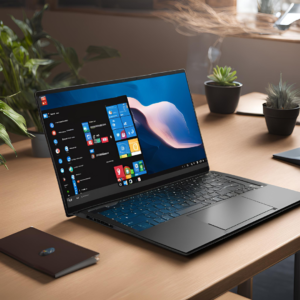Are Folding Phones the Future of Smartphones? Exploring the Pros and Cons
Introduction
Imagine unfolding your phone to reveal a larger screen, perfect for watching videos or multitasking. Sound futuristic? Welcome to the world of folding phones, a new trend shaking up the smartphone market. These innovative devices are capturing the imaginations of tech enthusiasts and gadget lovers alike. But are they worth the hype? In this post, we’ll explore the pros and cons of folding phones compared to traditional smartphones, helping you decide if it’s time to upgrade.
Understanding Folding Phones
What Are Folding Phones?
Folding phones are a new breed of smartphones featuring flexible displays that allow the device to fold in half. These phones offer a unique combination of portability and expanded screen real estate. The concept isn’t entirely new, but recent advancements in flexible display technology have made it more feasible. Companies like Samsung, Huawei, and Motorola are leading the charge, bringing these phones from concept to consumer hands.
A Brief History
The idea of a folding phone dates back to the early 2000s with flip phones that featured physical keyboards. However, the modern iteration with flexible OLED screens began gaining traction around 2019. Samsung’s Galaxy Fold was one of the first to hit the market, followed by Huawei’s Mate X and Motorola’s Razr. These early models faced challenges but also set the stage for rapid advancements.
Popular Folding Phone Models
Some of the most popular folding phones include:
- Samsung Galaxy Z Fold 3: Known for its robust build and multitasking capabilities.
- Huawei Mate X2: Praised for its seamless design and high-quality display.
- Motorola Razr 5G: A modern take on a classic, offering nostalgia with a tech twist.
These models represent the current state of folding phone technology and hint at what might come next.
The Pros and Cons of Folding Phones
Advantages of Folding Phones
Enhanced Screen Real Estate
One of the most significant advantages of folding phones is the expanded screen space. When unfolded, these devices offer a tablet-like experience, making them ideal for media consumption, gaming, and multitasking. Imagine watching a movie on your commute or splitting the screen to run multiple apps simultaneously. The extra screen real estate enhances productivity and entertainment options.
Innovative Designs
Folding phones are not just functional; they’re also incredibly stylish. The sleek, futuristic designs make them stand out in a sea of traditional smartphones. For tech enthusiasts who love to showcase the latest gadgets, folding phones offer a unique blend of form and function. The ability to switch between compact and expanded modes adds a wow factor that traditional phones can’t match.
Versatility
The versatility of folding phones is unmatched. They provide the convenience of a small, pocketable device with the functionality of a larger screen when needed. This dual nature makes them perfect for various scenarios, from taking quick calls to presenting a slideshow in a meeting. The adaptability of folding phones adds a layer of convenience that traditional smartphones lack.
Disadvantages of Folding Phones
Fragility
Despite their innovative designs, folding phones come with a set of challenges, the most notable being fragility. The flexible screens are more susceptible to scratches and damage compared to traditional glass screens. The hinge mechanism, essential for the folding function, can also be a point of failure. Manufacturers are working hard to improve durability, but it’s still a concern for potential buyers.
Weight and Bulkiness
Folding phones tend to be heavier and bulkier than their traditional counterparts. The additional components required for the folding mechanism contribute to this, making them less convenient for one-handed use. While they offer more screen space, the trade-off is a less streamlined form factor that can be cumbersome to carry around.
High Price Point
Innovation comes at a cost, and folding phones are no exception. These devices are generally more expensive than traditional smartphones, putting them out of reach for many consumers. The high price point can be a significant drawback, especially when considering the potential for fragility and other limitations. It’s a premium experience with a premium price tag.
The Future of Folding Phones
Predictions for the Future
The future of folding phones looks promising, but several hurdles remain. Analysts predict that as technology improves, we will see more durable, affordable, and versatile models. Companies are investing heavily in research and development to address current limitations and expand the capabilities of folding phones. Expect to see innovations like improved hinge mechanisms, more robust displays, and even new form factors.
Evolution to Address Limitations
Manufacturers are already taking steps to make folding phones more practical. Advances in materials science are leading to more durable screens and hinges. Software improvements are making better use of the unique form factor, with more apps optimized for folding displays. Battery life, another critical concern, is also seeing enhancements, ensuring that these devices can keep up with the demands of modern users.
Mainstream Adoption
For folding phones to become mainstream, they need to overcome the challenges of fragility, bulkiness, and high costs. However, as these issues are addressed, we can expect broader adoption. The unique benefits of folding phones—enhanced screen real estate, innovative designs, and unmatched versatility—make them a compelling choice for tech enthusiasts and everyday users alike. The tipping point may come sooner than we think.
Conclusion
Folding phones represent a fascinating evolution in smartphone technology, offering unique advantages like enhanced screen real estate, innovative designs, and versatility. However, they also come with notable disadvantages, including fragility, bulkiness, and high costs. The future looks bright, with ongoing advancements likely to address these limitations and make folding phones more accessible to the general public.
For tech enthusiasts, gadget lovers, and anyone intrigued by the next big thing in smartphones, folding phones are worth keeping an eye on. They offer a glimpse into the future of mobile technology, blending the best of both worlds—portability and expansive screens. Whether you’re ready to make the switch or just curious about what’s next, the world of folding phones is one to watch closely.
Are you excited about the potential of folding phones? Share your thoughts in the comments below and stay tuned for more updates on this rapidly evolving technology!
Share this content:












Post Comment